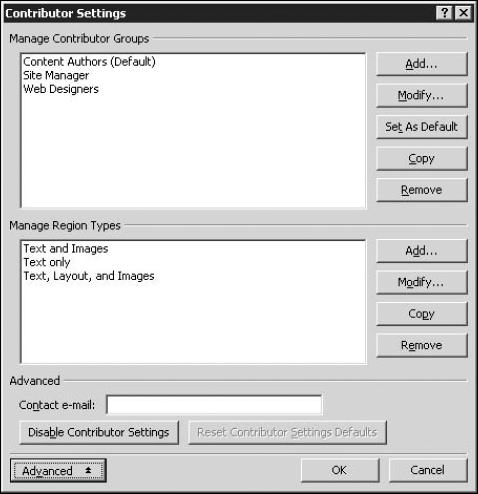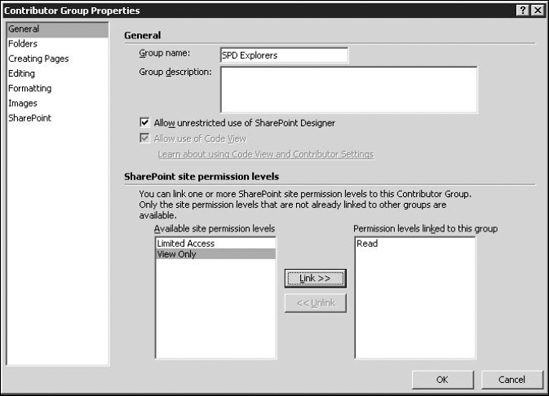24.3. Implementing Contributor Settings
Contributor Settings is a new offering in SharePoint Designer for SharePoint sites and allows an administrator to lock down SharePoint Designer features, commands, and menus based on the contributor group that the user using SharePoint Designer belongs to. This is particularly useful in scenarios where administrators (or site managers) want to direct their users to perform only site-editing operations of a specific type (such as creating and managing CSS) and not be able to perform any other operations, thereby saving the Web site from an unintentional or inadvertent site modification.
NOTE
Contributor Settings isn't a security implementation. It's just a lockdown mechanism that can be used with SharePoint Designer to prevent unintended Web site changes. Only a site administrator can enable or disable Contributor Settings.
The concept of Contributor Settings and the Contributor Mode can be fairly easy to understand if you don't confuse it with SharePoint permissions. This feature is implemented by using Contributor Groups, which can be created in SharePoint Designer and linked to Permission Levels in SharePoint.
24.3.1. Understanding Contributor Settings
To be able to understand Contributor Settings and the Contributor Mode in SharePoint Designer, you need to first understand the concept of permission levels in SharePoint. A permission level is basically a bundle of permissions. For example, the Full Control permission level has all the available permissions in it. By default, there are a number of permissions levels available for use with SharePoint sites. You can see the list of available permission levels in your SharePoint site by browsing to the Web site and then choosing Site Actions ![]() Site Settings
Site Settings ![]() Modify All Site Settings
Modify All Site Settings ![]() Advanced Permissions. On the Permissions page, choose Settings
Advanced Permissions. On the Permissions page, choose Settings ![]() Permission Levels to open the list of permission levels, as shown in Figure 24.4.
Permission Levels to open the list of permission levels, as shown in Figure 24.4.
Figure 24.4. The Permission Levels page in SharePoint Designer

Using this page, you can create new permission levels and then choose the list of permissions available for the permission level. Once the permission level is created, you can associate users (or groups) to a permission level so that the user (or group) has permissions that bundle up in the associated permission level.
In SharePoint Designer, you create contributor groups that are linked to these permission levels. A contributor group is basically an object that has a list of SharePoint Designer features, commands, and menu bars enabled for use. Each contributor group is linked to one or more permission levels. By default, SharePoint Designer has three contributor groups: Site Managers (linked to the Full Control permission level); Content Authors (linked to the Contribute permission level); and Web Designers (linked to the Design permission level).
So, the way this mechanism manifests in SharePoint Designer is through the following:
A user (or group) is added to the SharePoint site with a specific permission level. This could either be any of the default permission levels or a newly created permission level.
In SharePoint Designer, a contributor group is created and linked to a permission level.
When a user opens the site in SharePoint Designer with the Contributor Mode turned on, the permission level of the user dictates the contributor group the user should belong to. Based on the contributor groups the user belongs to, the SharePoint Designer interface is enabled or disabled for use.
NOTE
Contributor Mode is enabled by default in SharePoint Designer. Because there are three contributor groups created and linked to three permission levels, users accessing SharePoint sites should see the SharePoint Designer features enabled or disabled based on their permission levels.
When you open a SharePoint site that has Contributor Mode enabled for it, the title bar of SharePoint Designer indicates that the Contributor Mode is turned on, as shown in Figure 24.5.
Figure 24.5. SharePoint Designer with the Contributor Mode turned on
The Contributor task pane is also enabled, which indicates that the contributor settings are turned on, allows you to view your Contributor Settings, and shows the tasks you previously performed using SharePoint Designer.
24.3.2. Configuring contributor group properties
You work with the Contributor Settings in SharePoint Designer via the Site ![]() Contributor Settings menu. This menu opens the Contributor Settings dialog box, as shown in Figure 24.6, which allows you to create or modify contributor groups, manage region types, and toggle Contributor Settings off and on.
Contributor Settings menu. This menu opens the Contributor Settings dialog box, as shown in Figure 24.6, which allows you to create or modify contributor groups, manage region types, and toggle Contributor Settings off and on.
Figure 24.6. The Contributor Settings dialog box

The three contributor groups that are created by default in SharePoint Designer are shown in the Manage Contributor Groups section. To create a new contributor group, follow these steps:
In the Contributor Settings dialog box, click Add in the Manage Contributor Groups section. This opens the Contributor Group Properties dialog box, as shown in Figure 24.7. The left pane in this dialog box lists all the areas in SharePoint Designer where the features can be enabled or disabled.
In the SharePoint site permission levels section, choose the permission levels you want to link the contributor group to and then click Link.
Using the various options, such as Folders, Formatting, etc., in the list on the left, choose the features that you want to enable in SharePoint Designer for the contributor group. By default, all features are enabled. You can deselect the available check boxes to disable features.
You can use the Manage Region Types section in the Contributor Settings dialog box to create region types that can be associated with content regions in Master Pages by using the Manage Content Region menu option, as shown in Figure 24.8. After a content region is associated with a region type, a user can make only those modifications to the content of the content region that are considered valid according to the associated region type.
Figure 24.7. The Contributor Group Properties dialog box

While creating region types, you can specify if the settings should be inherited from the contributor group. Otherwise, you can override the inheritance and then specify your own settings for enabling and disabling features.
Figure 24.8. Using master page content regions with region types

